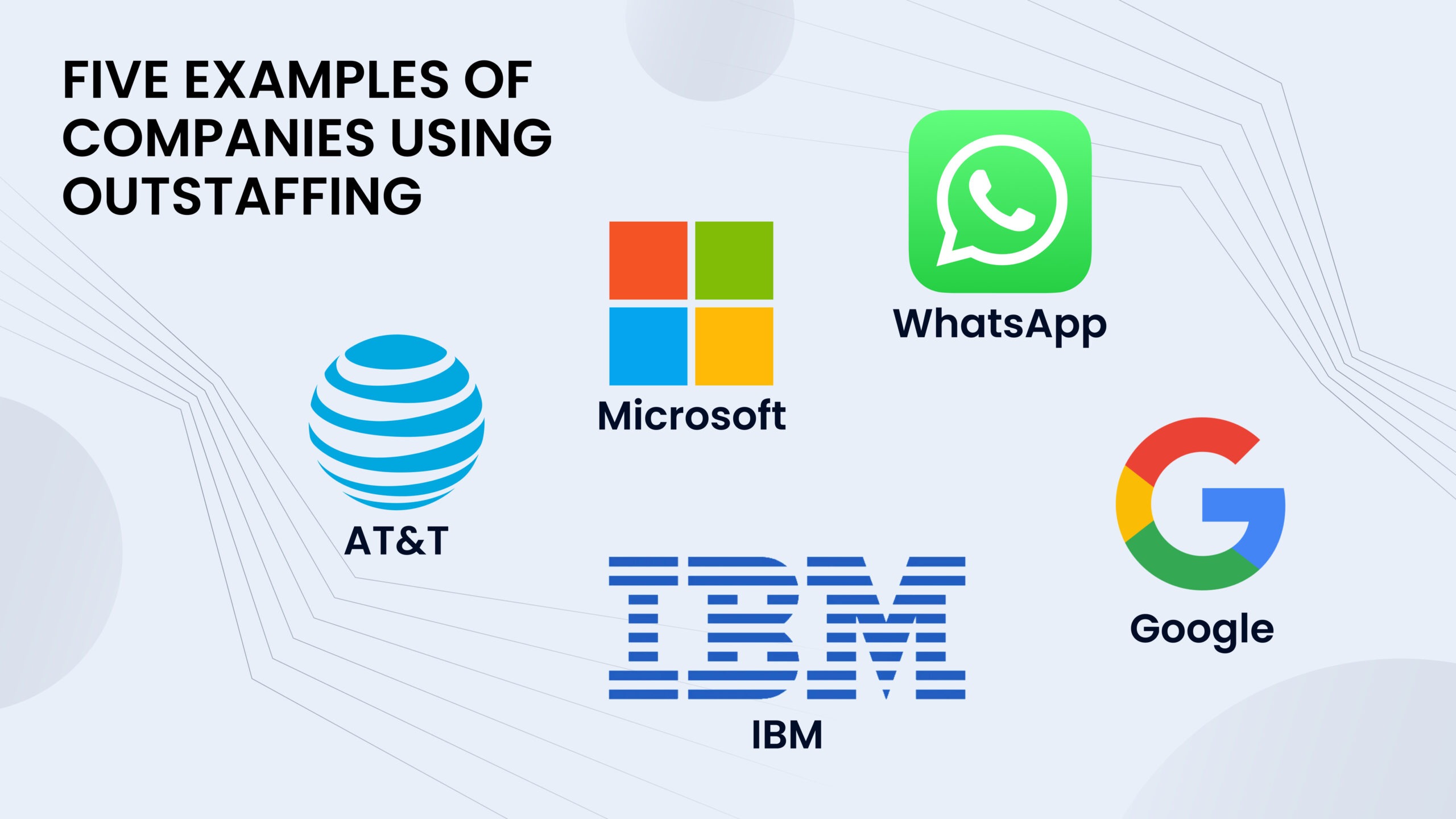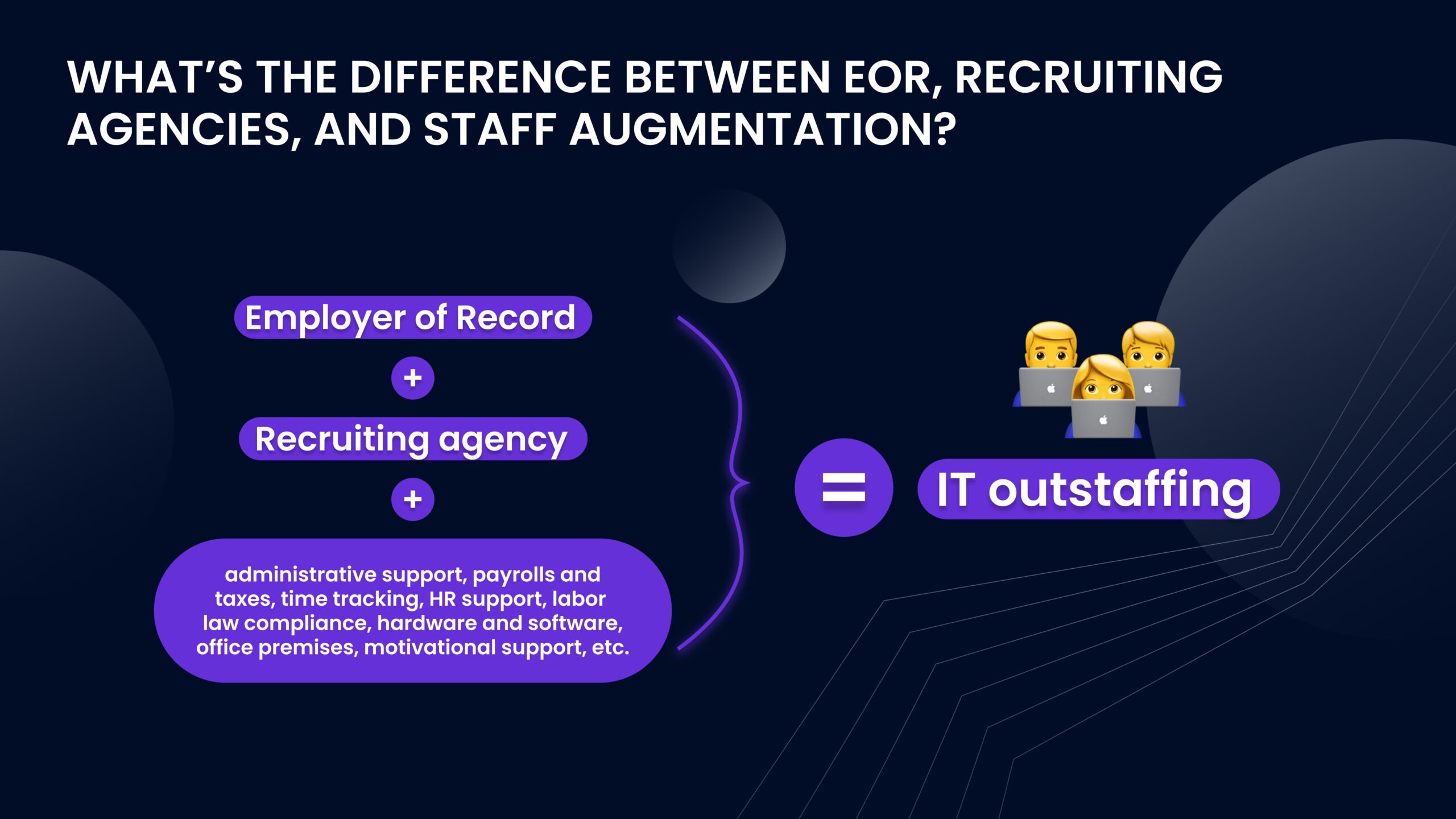
What if we tell you that a reliable outstaffing company can help you with most of the challenges in your tech business? Because it is a pretty universal solution for both startups and large enterprises, for those who want to have full control over their employees and those who don’t want to hire new people into their teams.
2025 is the high time to gain this kind of competitive advantage, as the last five years have been anything but smooth. A global pandemic and the subsequent quarantine restrictions plunged the world into an economic recession, followed closely by a grand-scale war in Europe and an escalation of the Israel-Palestine conflict. These geopolitical upheavals coincided with the rapid rise of AI tools and the digitalization of nearly every aspect of our lives.
Content:
- What is outstafing?
- What services does an out staffing company provide?
- What’s the difference between EOR, recruiting agencies, and staff augmentation?
- How can your business benefit from outstaffed team members?
- Why is MWDN your choice among staff augmentation vendors?
What does all this mean for the future? Simply put, 2025 is unlikely to offer much respite, especially for business owners who will need to adapt to these seismic changes, consider the risks of ongoing instability, and seize new opportunities. Thankfully, outstaffing is one tool that can significantly ease this journey.
What is outstafing?
Outstaffing, also known as staff augmentation, is a hiring strategy where companies temporarily expand their teams by bringing in external skilled professionals without committing to long-term employment. These people are technically employed by an outstaffing company but work as an integrated part of your team, contributing to projects and daily operations. This model allows businesses to fill specific roles or meet project demands quicker and more efficiently without the obligations associated with permanent hires.
Five examples of companies using outstaffing

Many startups, large companies, and tech giants engage in various forms of outsourcing, outstaffing, or contracting to meet their needs for specialized talent or to scale their operations. Here are some examples:
- Google has been known to outsource various non-core activities, and outstaffing is a natural extension of this practice, especially for highly specialized projects. They have also been involved in controversial discussions about their reliance on “shadow workforce” or temps, vendors, and contractors who are technically outstaffed workers.
- Microsoft uses various outsourcing and outstaffing models to manage its global operations. They have a history of partnering with global staffing firms to augment their teams for specific projects, especially in software development and IT services.
- IBM has a well-documented history of using outsourcing and outstaffing to manage its vast IT operations and global services. They frequently engage in partnerships with third-party firms to augment their workforce for specific client projects.
- Before its acquisition by Facebook, WhatsApp was known to have a very small core team, with much of its development work handled by engineers in Eastern Europe. This is a clear case of outstaffing being used to scale the company’s operations.
- Like many large telecommunications companies, AT&T relies on a combination of internal resources and external vendors, including outstaffing, to manage its network infrastructure and customer service operations.
What services does an out staffing company provide?
Staff augmentation vendors offer a range of services that cater to the dynamic needs of businesses seeking to expand their teams with top-tier talent. These services include providing dedicated teams, part-time and full-time hires, time-and-material cooperation, etc, each designed to offer flexibility and maximize efficiency.
Dedicated teams
Dedicated teams are specifically tailored to your projects. These teams work exclusively on your tasks, operating as a seamless extension of your in-house team. This approach is perfect for long-term projects that require focused attention and specialized expertise without the additional burdens of managing additional full-time employees.
Part-time and full-time hires
For businesses with fluctuating needs, outstaffing offers the option to hire professionals on a part-time or full-time basis. Part-time hires are ideal for projects that need specific expertise on a flexible, as-needed schedule, while full-time hires provide the advantage of having a dedicated professional working solely on your initiatives. This flexibility allows you to scale your workforce according to demand, without the long-term commitment of traditional employment.
What’s the difference between EOR, recruiting agencies, and staff augmentation?

While both Employer of Record (EOR) services and staff augmentation involve managing employment-related responsibilities, they serve different purposes. An EOR acts as the legal employer for workers, handling payroll, taxes, and compliance, typically for full-time roles. However, EOR services are limited in flexibility and are usually focused on permanent employment arrangements.
Staff augmentation, on the other hand, offers much more. It not only covers the employment and administrative functions of an EOR but also allows businesses to integrate external professionals into their teams on a temporary or project basis. This approach provides greater flexibility, enabling companies to adapt quickly to changing project requirements while accessing a global talent pool.
Recruiting agencies specialize in finding and placing candidates in permanent roles within a company. Their focus is on sourcing, vetting, and matching candidates for long-term positions. However, once the placement is made, the relationship typically ends, leaving the employer to handle all ongoing responsibilities.
In contrast, staff augmentation combines the recruitment process with ongoing employment management. An outstaffing company not only finds and vets candidates but also manages their employment, including payroll, benefits, compliance, and HR functions.
Staff augmentation is more than just a combination of EOR services and recruiting—it’s a complete solution. It offers the flexibility to scale teams as needed, access to a global talent pool, and administrative support to keep operations smooth.
How can your business benefit from outstaffed team members?
Outstaffing offers numerous advantages for tech businesses, providing flexibility, access to global talent, and cost savings. Here are 10 key benefits:

1. Cost efficiency
Hiring tech talent through outstaffing can reduce costs by up to 60%. For example, Israeli businesses can tap into Eastern European markets where developer salaries are significantly lower without compromising on quality. This reduction in labor costs directly improves your bottom line.
2. Access to a global talent pool
Outstaffing gives you access to a global network of skilled professionals, enabling you to find specialists in rare technologies or niches. This diversity often results in innovative solutions and a broader perspective on problem-solving.
3. Scalability
Whether you need to scale your team, outstaffing offers unparalleled flexibility. This is especially crucial for tech projects, where requirements can change rapidly. You can expand your team for a major project and then reduce its size once the project is completed without the complications of traditional hiring or layoffs.
4. Faster time to market
With a team ready to go, you can accelerate your project timelines. Outstaffing allows you to bypass lengthy recruitment processes and get straight to development, reducing the time to market for your product by as much as 30%.
5. Focus on core business
By outsourcing non-core tasks, your internal team can concentrate on strategic activities that directly contribute to business growth. This focus often results in better product development and customer satisfaction.
6. Reduced administrative burden
Outstaffing companies handle payroll, benefits, and compliance issues, freeing your HR department from time-consuming tasks. This reduction in administrative workload can lead to a 25% increase in HR efficiency, allowing them to focus on more strategic initiatives.
7. Risk mitigation
Outstaffing companies often have rigorous vetting processes, reducing the risk of bad hires. Plus, with contractual flexibility, you can easily replace underperforming team members, ensuring your project stays on track.
8. Enhanced innovation
With access to a broader range of skills and experiences, outstaffed teams can bring fresh ideas and innovative approaches to your projects. This diversity can lead to more creative solutions, helping your business stay ahead of the competition.
9. 24/7 productivity
Outstaffing across different time zones can allow your business to operate around the clock. This continuous productivity can speed up project timelines and provide quicker responses to any issues that arise, giving you a competitive edge.
10. Improved work-life balance for the core team
By outstaffing routine or overflow tasks, your core team can avoid burnout and maintain a healthier work-life balance. This approach can lead to higher job satisfaction and retention rates, ultimately benefiting your company culture.
Why is MWDN your choice among staff augmentation vendors?
MWDN stands out as a premier choice for outstaffing services, particularly in 2025. With over 20 years of experience in the industry, MWDN has honed its ability to provide top-notch professionals across various domains.
The company’s deep roots in Eastern Europe and Israel give it access to a vast network of highly skilled tech talent, ensuring that your business can tap into some of the best minds in the industry. MWDN not only offers competitive pricing but also guarantees the quality and reliability of its professionals, making it a trusted partner in your business’s growth journey.
In a world where adaptability is key, MWDN’s outstaffing services offer the perfect blend of flexibility, expertise, and efficiency, helping your business deal with the challenges of 2025 and beyond.


